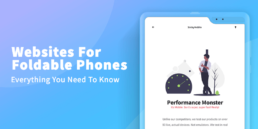
Mobile Websites for Foldable Phones
Foldable phones are not a new concept on the market. With their very first introduction of Royole FlexPai in 2018 and later Samsung’s Infinity Flex Display, foldable phones took the industry by storm.
The concept is pretty simple: You have a phone and a small tablet in one single device. Although the technology for them is under development and currently presenting issues when in normal use, people are excited to see the final outcome of such a device.
But what about creating websites for them? Responsive designs may be a solution, but considering the volatile nature of the still under development design, it is hard to create a responsive website for it. Some open up like a book, like Samsung Galaxy Fold, while some open up vertically, like Mototrola’s RAZR. And there are many other problems we’ll cover in this article that just make the folding phones a promising, yet unfinished project.
1. Tech Giants
One of the main reasons for the lack of popularity of folding phones is their prices and endorsements from the big tech giants. We see phone manufacturers such as Motorola, Samsung and Huawei investing tons of money in R&D for this technology of foldable screens, but they are not backed up by the general internet software.
Is it a Tablet or a Phone? How do developers know what to create for? Google doesn’t add much support to the table. While it is currently developing the AMP Project, which stands for Accelerated MOBILE Project, it doesn’t show any interest in developing for tablets.
And they should, if they want to create a great user experience. We stand strong for dedicated websites for each screen size. You can check out more about dedicated mobile websites, and why you should definitely invest in one here.
Responsive softwares are just a quick fix. Take for example Apple and their experience with responsive software: iOS on iPads. It was awful. However, even if you liked it, it is just pointless to NOT take advantage of the additional screen a tablet can provide. This is exactly the reason for which they created iPadOS: a dedicated operating system for Tablets!
Responsive is not the answer, and this also applies for websites. You need to take care of the software in order to emphasise the hardware accordingly at its highest and make sure your users have a gorgeous user interface that doesn’t make their experience a fluid mess.
2. Dimensions
We’ve mentioned the fact that the physical dimension of each foldable phone’s screen is very different. This is because each manufacturer experiments in order to find out the perfect fit for a foldable phone. But every phone has different dimension and resolution, why is this a problem? True, but at least they look like a phone and some additional pixels and inches here and there do not mess up an entire website. A tablet does, because it basically adds another phone screen near the existing one.
When we talk about phones like Motorola’s RAZR, which folds and unfolds vertically, there is no issue. The only issue in this case is for people that have landing pages, or just a page with very little information. It will look awful when unfolded if the screen gets very, very long. And this is a very large part of the internet, so we’ll see where this goes.
3. Technical Difficulties
Typography can cause major problems when talking about foldable screens. Each size needs extra attention to details if you want to create the best user interface and user experience. This is where responsive website usually fail considerably. Each heading, text, icons and columns act differently depending on the size of the actual screen.
Moreover, pictures and galleries unveil another problematic aspect: they stretch too much or hidden completely when on “tablet mode”. This can negatively affect the aspect of the overall website and frustrate the end user. Why did I see that picture with my phone folded, but when I want to take a closer look, in disappeared when I unfolded the phone?
Let’s say that users don’t care too much about this. However, even if we completely ignore this, we cannot ignore the amount of data that is still loaded but not shown. Serving invisible content is not only pointless, but hurtful for the speed of your website.
On mobile, speed is everything. Nobody want to wait 10 seconds for your website load a photo, not to mention an invisible photo. For more information on the importance of speed in developing mobile websites and why Google cares about this, you can check our article here.
4. Our Opinion
We’ve been developing mobile websites and apps for more than 13 years and we love to see such advances in mobile hardware. More and more mobile devices are growing in power and are as capable if not more than some computers out there. It is extremely fascinating to see such a rapid growth.
However, rapid growth can lead to unforeseen consequences. In this case of folding phones, big manufacturers tend to be caught up in a crazy race between themselves and forget that actual people will use those phones. Many hardware related aspects are being problematic, not to mention that software was completely left behind.
But what is hardware without a proper software? Well, the first iPhone is a great example. You could have revolutionary piece o technology just to see minified desktop versions of websites on a very tiny screen.
For sure, the software for websites will be a main concern and, most likely, we’ll be developing tablet dedicated websites for these mobile phablets, but until then, we’re very excited to see how the final and stable product will look like!
What is your opinion on folding phones? We’d like to hear from you! Also if you want to receive the latest news and discounts, you can subscribe to our newsletter here.
